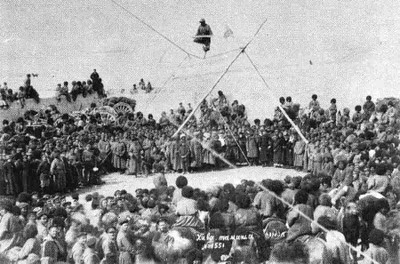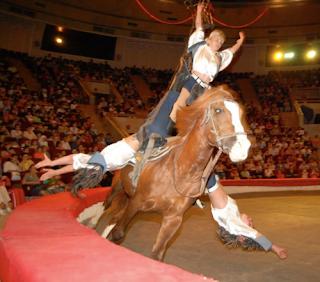 |
| A rope walker in Khiva, late 19th century |
In the centre of the improvised stage they set up a dor - a construction of ropes and the trunks of poplar trees - designed for the dorboz, or rope walkers. Then the performance was announced by loud playing of karnays and sunrayas, the Uzbek wind instruments, accompanied by drums and tambourines.
The rope walker appeared on a thin rope, high above the spectators' heads, doing difficult and risky acrobatic stunts. At a height of up to 25 metres and without safety equipment, the dorboz, sometimes blindfolded, walked, ran, and did the splits. As the crowds gasped, the performance continued with jugglers, stilt walkers and 'wisecrackers', who entertained the crowds with jokes and poems. As these performances evolved, animal trainers and illusionists joined the shows and, drawing on superb horsemanship honed for centuries on the Central Asian steppe, equestrian events were added.
 |
| Soyuza Zaripova, the first Uzbek female clown |
Several dynasties dominate the circus profession in Uzbekistan: the Tashkenbaevs, the Zaripovs, and the Khojaevs. While continuing to innovate, these families ensure that the secrets of the ancient and original arts are not lost.
 |
| Thrilling horsemanship at the Tashkent Circus |
Uzbek circus performers are so respected for their skills, that they are frequently invited to join other circuses. There was a recent article in the Bangalore Mirror about Khamarshah Mostov and Elnur Imomnazarov, two graduates of the four-year degree course in acting and circus arts at Tashkent's Circus College; they graduated in juggling and acrobatics and are now under contract to India's Gemini Circus. They were inspired by the film Mera Naam Joker, in which the Indian actor, Raj Kappor (who was wildly popular in the USSR) played the clown.
 |
| Uzbek clowns Khamarshah Mostov and Elnur Imomnazarov |
Related posts:
The Jabborov Rope Walking Family of Khiva
Bukhara's Puppet Theatre
Tashkent's Soviet Buildings (to view the circus building)
Materials source: Many thanks to Uzbek writer Nigora Abdukayumova, who is now based in Manila, Philippines.